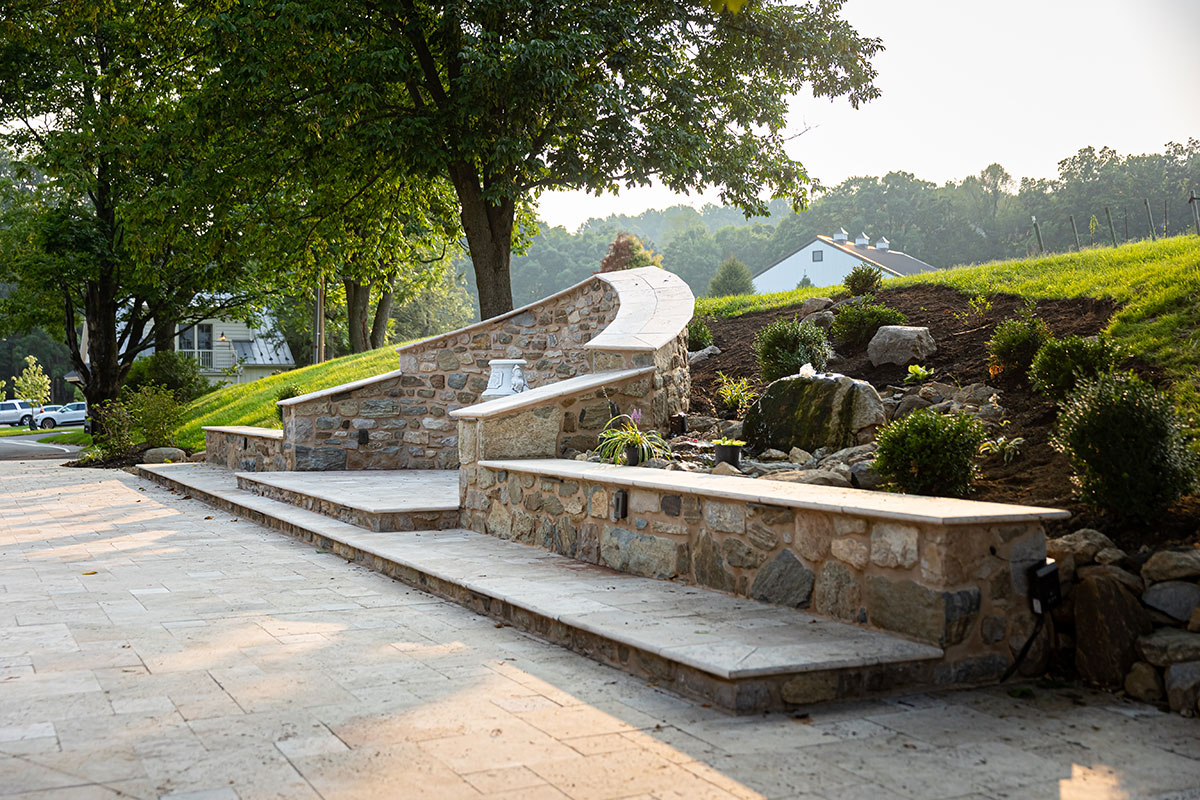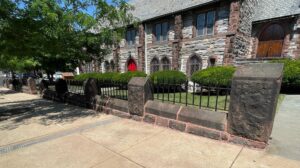Are you planning a renovation or construction project involving stonework?
Stone masonry, with its durability and aesthetic appeal, requires precision and expertise to achieve the best results. Here at Stable Hollow Construction, we have dedicated crews that provide repointing, repairing, building, and other types of restoration for all types of historic buildings and stone structures, including churches, barns, fireplaces, and retaining walls.
We are certified to install JAHN mortar, which allows our crews to repair and restore historic and natural stone masonry without a complete reconstruction. JAHN mortars can be tailored to replicate the color, texture, and composition of the original masonry or stone, ensuring repairs are nearly invisible once completed. Furthermore, we have a dedicated stonemason who carves datestones by hand.
Below is more information about stone masonry and how it can restore timeless structures here in Lancaster, Pennsylvania and the surrounding areas.
The Importance of Stone Masonry in Old Buildings
Old buildings made from stone are often admired for their aesthetic value, longevity, and cultural significance. Restoring these structures preserves the buildings themselves and the stories and heritage they represent—something that is very important here in Pennsylvania Dutch country.
One of the most remarkable qualities of stone masonry is its exceptional durability. Properly constructed stone buildings can last for centuries, withstanding weather, time, and environmental conditions. Stones like limestone, granite, bluestone and iron stone are highly resistant to wear and tear, and they require less upkeep compared to modern materials. This is especially important for old buildings where the goal is to preserve the materials and maintain authenticity. The methods, techniques, and tools used by Stable Hollow masons are the same as those that built these buildings centuries ago.
Stone masonry also reflects the artistry and ingenuity of masons from past centuries. Lancaster County has a rich history, spanning across three centuries, evident in its varied architecture. Stone masonry preserves both public and private buildings and helps the community retain its historical identity. In each of the counties we work in we see variations of the natural fieldstone used for many of the historic buildings. This creates a unique and signature look for each area and can vary from town to town and county to county.
What Does Stone Masonry Entail?
Stone masonry is a traditional construction technique that involves shaping, arranging, and binding natural stones to create structures and architectural elements. It combines the best of craftsmanship, engineering, and artistry to produce durable and visually attractive buildings, walls, and decorative features. Despite advances in technology, stone masonry is nothing new. In fact, it has been used for centuries in construction, demonstrating its strength, longevity, and aesthetic versatility.
Stones and Mortars Used in Stone Masonry
A variety of natural stone materials are used in stone masonry, and they are selected based on the project’s structural and aesthetic requirements. Here at Stable Hollow, our skilled stonemasons have experience working with a wide range of stones, such as:
- Granite. Strong and durable, often used for foundations and outdoor structures.
- Indiana Limestone. Soft and easy to work with, ideal for decorative and load-bearing structures.
- Blue Stone. Similar to Indiana Limestone but with a distinct blue-grey tone and more challenging to split and shape.
- Sandstone. Known for its natural beauty, often used in building facades and landscaping.
- Marble. Valued for its elegance, frequently used in monuments and interiors.
- Slate. Used for roofing, flooring, and cladding due to its layered structure.
- Fieldstone. Uncut, naturally occurring stones for a rustic look.
In historic stone masonry, the choice of mortar is crucial for the structure’s stability, durability, and preservation. Different types of mortar have been used historically, each with unique properties suited to specific conditions and materials. The main types of mortar used in historic stone masonry are lime mortar, cement mortar, and a mix of both, each offering distinct benefits.
Lime Mortar
Lime mortar has been the traditional binding agent in masonry for centuries. Made from lime (calcium oxide), sand, and water, lime mortar is highly porous and flexible, which allows for movement and expansion in the masonry without causing damage. This flexibility is particularly beneficial in historic structures that may have settled or shifted over time. Lime mortar is also vapor-permeable, meaning it allows moisture to evaporate, preventing water from being trapped inside the stone. This is important because trapped moisture can lead to deterioration of both the stone and the mortar. Additionally, lime mortar is less prone to cracking compared to modern materials and can be repointed (the process of renewing mortar joints) easily, preserving the original character of the building.
Cement Mortar
While cement mortar has largely replaced lime mortar in modern construction, it was occasionally used in historic masonry, especially in the 19th and 20th centuries. Cement mortar is more rigid and durable than lime mortar, providing a stronger bond between stones. It is less porous and can withstand weathering better than lime mortar in some conditions. However, its lack of flexibility means it can trap moisture inside the masonry, leading to potential issues like efflorescence, cracking, and spalling of the stones over time. Because of its strength, cement mortar is often used for repairs where the structural integrity of the building is at risk, but it is generally avoided in conservation work due to its incompatibility with older materials.
Hydraulic Lime Mortar
A middle ground between pure lime and cement mortar is hydraulic lime mortar. This type of mortar sets and hardens even underwater, making it suitable for areas exposed to higher moisture or more severe weather conditions. Hydraulic lime contains natural clay minerals that allow it to harden more quickly than non-hydraulic lime, yet it still maintains the breathability and flexibility of lime mortar. There are various formulas to select from depending on the location of the application and how much moisture it may encounter. It is often used in repairs to historic buildings where conditions require more durability without compromising the material integrity of the stone.
Each of these mortars offers distinct benefits depending on the preservation goals and environmental conditions of the structure. Lime mortar, in particular, is favored for its compatibility with older stone and its ability to “breathe” while maintaining a gentle bond that won’t harm the underlying materials. For repairs and conservation of historic stonework, understanding the type of mortar originally used and its characteristics is essential to ensuring the longevity and authenticity of the building.
Why Restoration is Key
The Lancaster, Pennsylvania region has been shaped by more than 250 years of history, much of which is still seen in old buildings and neighborhoods. Restoring these buildings is more than just preserving bricks and mortar; it’s about protecting our history, culture, and community identity. By investing in stone masonry, we can preserve Pennsylvania’s history and heritage, boost the local economy, and even inspire future generations. No matter what structure you plan on restoring, know that together, our efforts ensure these structures remain part of our shared story for years to come.
Choosing the Right Stone Masonry Professionals
Stone masonry is both an art and science, requiring skill, precision, and a deep understanding of various materials and techniques. Whether you’re restoring a historic structure, building a new stone feature, or repairing existing masonry, choosing the right professionals is crucial for achieving the high-quality results you’re expecting.
Some tips for choosing the best stonemasons include:
- Experience and expertise. Stone masonry is a specialized craft that takes years to master. Ensure the professionals you hire have extensive experience handling these types of projects, a diverse portfolio to assess their work ability, and specialized knowledge for your specific project, such as ashlar masonry, rubble masonry, or dry stone masonry.
- Certifications and training. Masonry professionals with certifications and formal training are more likely to deliver high-quality work. Look for trade certifications, historic preservation training, and safety certifications. Stable Hollow is a proud member of the Timber Framers Guild, Manheim Historical Society, Historic Gettysburg-Adams County Perseveration Society, Historic Barn and Farm of Pennsylvania Foundation, and the Historic Preservation Trust of Lancaster County.
- Transparency in planning and costs. Reliable masonry professionals are transparent about all planning and costs. In fact, they take a collaborative approach where they work closely with you to bring your vision to life. You should also receive a detailed cost breakdown of labor, materials, and other expenses.
Expert Stonemasons in Lancaster, Pennsylvania
Stable Hollow offers stone masonry services in Lancaster, PA and within a two hour drive from our home office in Manheim. This includes the Main Line towards Philadelphia, northern Maryland, historic Adams County PA, York County, Harrisburg PA and much of the surrounding rural areas. Our team of skilled stonemasons brings expertise and dedication to every project, ensuring you get the high-quality results you are looking for while maintaining the structural integrity of the structure. Contact our team today at 717-665-0580 to learn more about having something unique crafted just for you!

